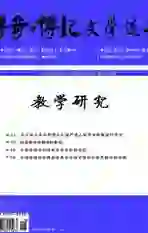Research and Application of Constructivism—based Reading Teaching in Vocational Colleges
2013-09-16田庆武刘佳
田庆武 刘佳
ABSTRACT
Reading plays an important role in language learning. It is an essential channel for students to acquire knowledge and communicate with others. Reading is also an indispensable step of language input. Constructivism is one of the important branches of cognitive theory. According to constructivism, the nature of learning is that the students actively make their own meaning construction under a certain circumstance. During the process, communication and cooperation are of great importance.
ⅠDefinition and Instructional Principles of Constructivism
Constructivism, an important branch of cognitive learning, is first proposed by Jean Piaget in the 1960s. Then many learners and scholars were dedicated to working it out into a complete theory system. Over time, an enormous number of literatures on constructivism have been evolved. Generally speaking, constructivism is loose and even without a complete system. Some person even comments, “The number of constructivists is the number of the constructivism theories.”(Yang, 2006:98).
Constructivism centers on students and regards students as the active subjects of meaning construction. The teachers are expected not to convey or instill knowledge into students, instead, to help and assist the students meaning construction. In the constructivist learning environment, the roles and functions of the teachers and the students have undergone great changes in contrast with the traditional teaching. A great number of constructivists have put forward their own understanding of views of the principles of constructivism teaching in large quantities.
ⅡProblems in English Reading Teaching in Vocational Colleges
Teaching of reading skills is ignored while too much emphasis was given to vocabularies and grammar (Fang Fang, 2010:61). In the teaching, Teachers pay too much attention to words, grammar and translation of text. Correspondently, the students mistake the aim and purpose of reading for memorizing new words, grammatical rules together with translation of paragraphs. The lack of exercise in reading skills leads to the students poor performance in reading.
The current English reading teaching is detached from real context (Fang Fang, 2010:61). This leads to the separation of what the students have learned in the reading from the real life. The students active and communicative initiative from the reading will be damped by this situation.
ⅢConstructivism and English Reading Teaching in Vocational Colleges
Facing the above problems in English reading teaching in vocational colleges, some researchers made attempts to solve them via employing constructivism.
Constructivism advocates the student-centeredness in learning, the importance of situation creation in teaching, interaction and communications as well as meaning construction. These advocates are just useful solutions to the problems in current English reading teaching in vocational colleges.
At first, in the light of constructivism, students are always regarded as the center of the whole teaching activity, the relationship of students and teachers in constructivism is that the students play principal roles while the teachers are supporters, facilitators and guides in the teaching activity.Secondly, constructivism stresses the importance of situation creation where the actual learning and meaning construction take place. Thirdly, interaction and communication is indispensable in constructivist teaching. As a result, a communicative and interactive bilateral relationship between students and teachers may well be assured if the teaching is based on constructivism.
Bibiliography
[1]方芳.建构主义学习理论对高职英语阅读教学的启示[J].职教论坛,2010(3)
[2]金锦.建构主义理论在高职高专英语阅读教学中的应用[J].开封教育学院学报,2011(3)
[3]杨莉萍. 社会建构论心理学[M].上海:上海教育出版社,2006
